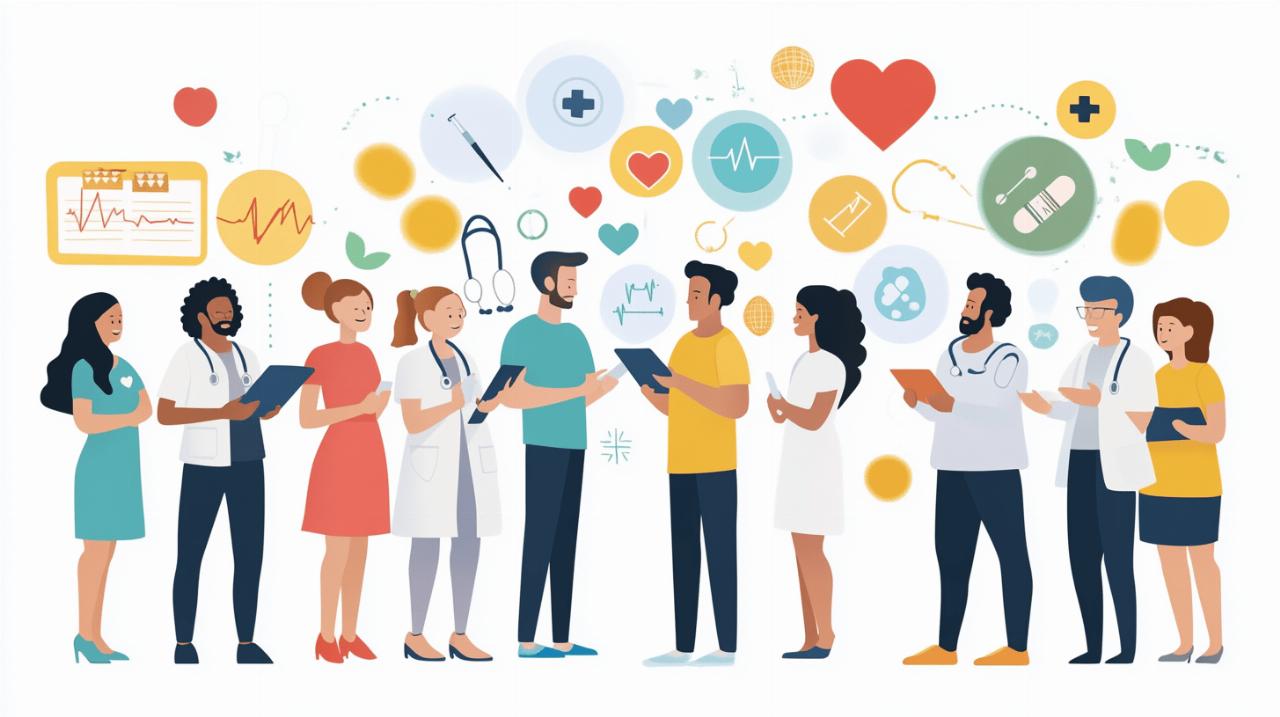Understanding your audience's needs
Effective health communication begins with a thorough understanding of your target audience. Healthcare professionals must recognize that different demographic groups have unique characteristics, preferences, and health concerns. For instance, elderly patients often have different communication needs compared to younger populations. A comprehensive study reviewing literature from 2000 to 2023 identified that tailored communication strategies significantly improve patient-centred outcomes for older individuals. As highlighted on https://www.comunicasalud.es/, understanding these nuances is crucial for developing health messages that resonate with specific audiences.
Identifying demographic characteristics and preferences
Demographic factors such as age, education level, socioeconomic status, and cultural background profoundly influence how individuals receive and process health information. NHS Employers guidance emphasizes the importance of understanding organizational demographics when planning health campaigns. For instance, if targeting a message about knee injuries to cyclists, the communication approach would differ significantly from messages about calcium intake for those at risk of osteoporosis. Recognizing these distinctions allows health communicators to craft messages that address specific concerns and motivations of different audience segments.
Assessing health literacy levels and information gaps
Health literacy—the ability to obtain, process, and understand basic health information—varies widely across populations. Research shows that verbal communication significantly impacts patient awareness, health literacy, and ultimately physical and mental health outcomes. When health communicators accurately assess literacy levels, they can bridge information gaps more effectively. This assessment involves recognizing knowledge deficits while acknowledging existing understanding, creating a foundation for meaningful engagement rather than patronizing instruction.
Using clear and accessible language
Medical terminology often creates barriers to effective health communication. Healthcare professionals must translate complex concepts into everyday language without sacrificing accuracy. Studies have demonstrated that patients better understand and retain information when it is presented in plain, accessible terms. This approach is particularly vital when addressing topics like treatment options for conditions such as herniated discs or explaining preventative care strategies.
Translating medical terminology into everyday speech
Healthcare communication often fails when clinicians use jargon that patients struggle to comprehend. For example, rather than discussing “myocardialinfarction,” using “heartattack” makes information immediately accessible. Similarly, instead of referring to “osteoporosispreventionthroughnon-dairycalciumsources,” speaking about “keepingbonesstrongwithplant-basedfoods” creates immediate understanding. This translation process requires skill and practice but significantly enhances patient comprehension and engagement with health recommendations.
Structuring messages for maximum comprehension
Beyond vocabulary choices, the structure of health messages substantially impacts understanding. Information should follow a logical sequence, beginning with the most essential points. Studies reviewed in healthcare communication literature recommend using the “teach-back” method, where patients explain information in their own words to confirm understanding. Additionally, breaking complex topics into manageable segments helps prevent cognitive overload, especially when discussing multifaceted health issues like the social determinants of health or chronic disease management.
Selecting appropriate communication channels
The medium through which health information is delivered significantly impacts its effectiveness. Healthcare communicators must strategically select channels that best reach their intended audience while considering accessibility factors. Research indicates that interventions delivered via telephone improved patient perceptions, demonstrating how channel selection influences outcomes.
Digital platforms versus traditional media options
Digital health communication offers unprecedented reach and personalization opportunities, while traditional media maintains importance for certain demographics. Social media platforms enable rapid information dissemination and community building around health topics, as seen in campaigns addressing topics like water rescue training or nutritional guidance. Meanwhile, printed materials remain valuable for audiences with limited digital access or those who prefer tangible resources. The most effective approach often combines multiple channels to reinforce messages across different touchpoints.
Matching channels to audience accessibility factors
Accessibility considerations must guide channel selection decisions. For elderly populations, who may have vision impairments or limited digital literacy, large-print materials or in-person communication might prove most effective. Conversely, younger audiences typically respond well to mobile applications and social media content. NHS campaign guidance emphasizes understanding when and how target audiences prefer to receive information, suggesting that timing can be as crucial as the channel itself.
Creating engaging visual content
Visual elements significantly enhance health communication by making complex information more digestible and memorable. Research demonstrates that well-designed visuals can overcome literacy barriers and cultural differences when conveying health concepts. The effective use of visual content supports greater retention of health information across diverse audience segments.
Designing infographics that simplify complex information
Infographics transform complex health data into accessible visual narratives. For instance, explaining the eight social determinants of health through an infographic makes these interconnected factors more comprehensible than text alone. Similarly, visualizing the progression of conditions like Parkinson's disease or the benefits of treatments such as NEUPRO helps patients and families better understand medical information. Effective infographics balance simplicity with accuracy, using clear visual hierarchies to guide viewers through information logically.
Using photographs and illustrations to enhance message retention
Strategic use of photographs and illustrations creates emotional connections and improves recall of health information. Images showing real people experiencing health challenges or demonstrating healthy behaviours create relatability and motivation. Studies in health communication have found that appropriate visuals significantly improve comprehension and retention of health messages. When selecting images, health communicators must ensure cultural relevance and sensitivity while avoiding stereotypes that might alienate portions of the target audience.
Fostering active listening and participation
 Effective health communication extends beyond message delivery to creating dialogues that encourage audience engagement. Healthcare providers who practice active listening identify patient concerns more accurately and build stronger therapeutic relationships. Non-verbal aspects of communication, including touch, smiling, eye contact, and maintaining appropriate physical distance, significantly influence patient satisfaction and wellbeing outcomes.
Effective health communication extends beyond message delivery to creating dialogues that encourage audience engagement. Healthcare providers who practice active listening identify patient concerns more accurately and build stronger therapeutic relationships. Non-verbal aspects of communication, including touch, smiling, eye contact, and maintaining appropriate physical distance, significantly influence patient satisfaction and wellbeing outcomes.
Building interactive communication opportunities
Interactive approaches transform health communication from passive information reception to active engagement. Techniques like the BATHE method (Background, Affect, Trouble, Handling, Empathy) help healthcare providers structure conversations that elicit meaningful patient participation. Similarly, community forums, health workshops, and digital platforms with feedback mechanisms create spaces for dialogue rather than monologue. These interactive opportunities allow health communicators to address misconceptions in real-time while building community around health topics.
Gathering and incorporating audience feedback
Feedback mechanisms are essential for continuously improving health communication efforts. NHS campaign guidance emphasizes the importance of measuring, evaluating, and adjusting approaches based on audience responses. Formal evaluation methods might include surveys or focus groups, while informal feedback can be gathered through social media engagement or conversation. This information helps refine messages, adjust delivery methods, and ensure that health communication remains relevant to evolving audience needs.
Ensuring accuracy and reliability
In an era of abundant health misinformation, establishing and maintaining credibility through accurate, evidence-based communication is paramount. Healthcare communicators must balance accessibility with factual correctness, ensuring information is both understandable and scientifically sound. This balance requires careful attention to source quality and staying current with evolving medical knowledge.
Vetting information sources and staying current
Rigorous source evaluation forms the foundation of reliable health communication. Health communicators must critically assess research methodology, publication credibility, and potential conflicts of interest before incorporating information into their messages. For example, when discussing treatments like those for herniated discs or knee injuries in cyclists, referencing peer-reviewed studies provides stronger evidence than anecdotal reports. Additionally, regular review of current literature ensures that health messages reflect the latest scientific understanding rather than outdated concepts.
Balancing simplicity with factual correctness
Making health information accessible without sacrificing accuracy presents a significant challenge. Simplification should clarify rather than distort scientific concepts. For instance, when explaining the importance of calcium intake for bone health, communicators might omit technical details about cellular mechanisms while still accurately presenting recommended intake levels and food sources. This balance requires expertise in both the health topic and communication principles to determine which complexities can be streamlined without compromising factual integrity.
Promoting cultural sensitivity and inclusivity
Cultural factors profoundly influence health beliefs, practices, and communication preferences. Effective health communication acknowledges and respects these differences while ensuring messages resonate across diverse populations. Research indicates that culturally competent communication improves health outcomes by increasing trust, adherence to recommendations, and overall engagement with health services.
Recognising diverse beliefs and health practices
Different cultural groups often hold varying perspectives on health, illness causation, and appropriate treatments. Health communicators must approach these differences with respect rather than judgment. For example, understanding traditional healing practices alongside conventional medicine creates space for integrated approaches that honour patient values while promoting evidence-based care. This recognition extends to acknowledging how factors like religion, family structures, and historical experiences shape health behaviours and decision-making processes.
Adapting messages for cultural relevance
Cultural adaptation goes beyond language translation to ensure health messages align with the values, beliefs, and communication styles of target communities. Imagery, examples, and metaphors should reflect the lived experiences of the audience. For instance, nutrition guidance might reference culturally specific foods rather than presenting a one-size-fits-all approach. Additionally, message framing should consider cultural values around concepts like individual versus collective responsibility for health, prevention versus treatment orientation, and traditional versus modern approaches to wellbeing.
Testing and refining communication strategies
Even the most carefully crafted health communication benefits from systematic testing and refinement. This iterative process ensures messages effectively achieve their intended outcomes before wide-scale implementation. Evidence from health campaign literature suggests that preliminary testing significantly improves message effectiveness and resource efficiency.
Conducting pilot tests with target audiences
Pilot testing involves presenting draft messages to representatives from the target audience to gather feedback before full implementation. This process identifies potential misunderstandings, cultural missteps, or logistical barriers early when adjustments remain feasible. For example, before launching a campaign about healthy nutrition options like tuna cakes with dried tomatoes, testing the messaging with various demographic groups helps ensure the information is appealing and actionable across different cultural and socioeconomic contexts.
Measuring effectiveness through meaningful metrics
Comprehensive evaluation frameworks help health communicators assess both process and outcome measures. Process metrics might include reach, engagement levels, and message comprehension, while outcome measures focus on knowledge acquisition, attitude changes, behavioural intentions, and ultimately health behaviours or status. NHS guidance emphasizes producing evaluation reports that support data-driven planning for future initiatives. These assessments should align with the SMART objectives (Specific, Measurable, Achievable, Relevant, Time-bound) established during planning stages to provide meaningful insights into communication effectiveness.

